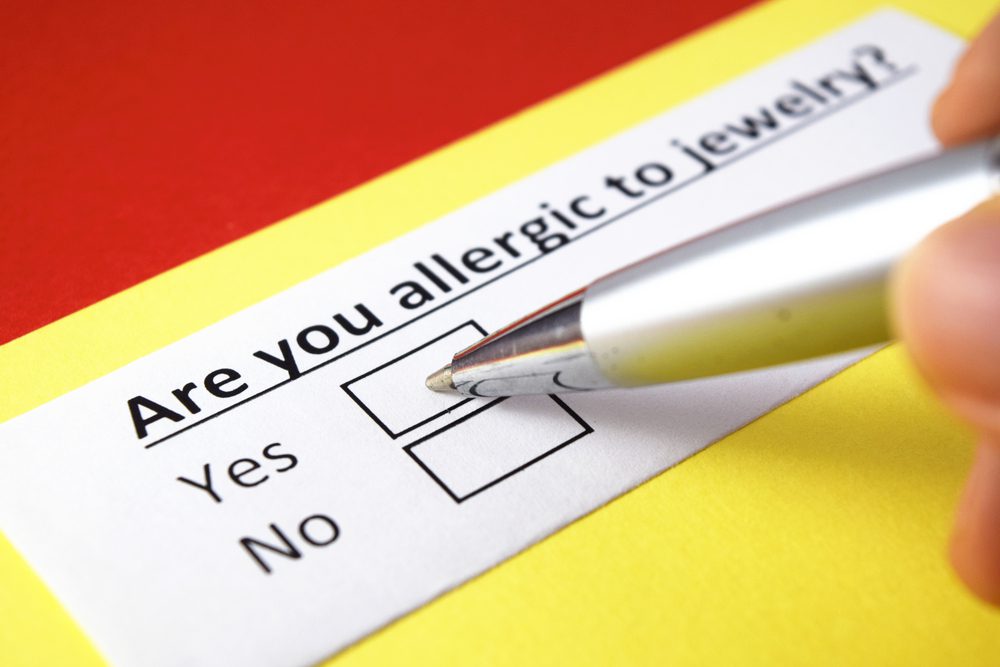According to the Asthma and Allergy Foundation of America, more than 50 millions of Americans have experienced a certain type of allergy every year.
By now, we’re all aware of the most common allergens such as pollen, dust, pets or peanuts. However, there are many other factors that could trigger this reaction – and some of them are far more commonly used than you would think!
Today, we’ll have a look at 10 everyday objects that might trigger an allergic reaction. Read on and see if any of these things ring a bell!

9 Common Things You Might Be Allergic To
Jewelry
One of the most surprising things on our list, jewelry can sometimes trigger an allergic reaction.
Silver-colored jewelry, for example, is usually made with nickel. This material is one of the most common causes for allergic contact dermatitis, an itchy skin rash. In fact, 17% of women and 3% of men are suffering from a nickel allergy*.
*Note that the percentage difference is only caused by the fact that women wear jewelry more frequently, which makes the condition easily detectable.
In order to test whether jewelry is the real cause behind this issue, you can simply switch to items made of real silver or gold. In rare cases, though, gold can also trigger an allergic reaction – especially if you’re also wearing plenty of makeup. How?
Kevin McGrath, MD, spokesperson for the American College of Allergy, Asthma, and Immunology, explains that the chemicals found in most makeup products can break down the gold which might lead to skin reactions.
If most jewelry out there causes allergic reactions, platinum may be your best fit.
Smartphones and tablets
Well this would be pure bad luck, wouldn’t it?
Unfortunately, people with metal allergies have a very difficult time using tablet devices, PDAs or cell phones. That is because, once again, most of these devices include nickel and cobalt (common allergens) – and that includes iPhones and iPads.
According to Dr. McGrath, the most common symptoms are rashes on face, years and hands along with eye irritation if you touch your eyes after using the phone.
What’s even worse is that once you develop a metal allergy, you’ll have to live with it for the rest of your life. However, anyone should be perfectly safe using such devices as long as they have a protective case on.
On the bright side, most allergies out there can be reversed through allergy shots.
Flea market furniture
If you’ve already been diagnosed with a dust or mold allergy, you should think twice before bringing any pieces of furniture into your home – especially if we talk about sofas, chair or beds.
Donna S. Hummell, MD, medical director of the Vanderbilt University Asthma, Sinus, and Allergy Program, explains that non-washable fabrics or carpets can gather plenty of dust mites and mold spores. If such furniture is heavily contaminated, your allergy symptoms can worsen dramatically.
No matter how good an item might look, it’s best to think twice before using it. If you truly want a certain item, you could double check whether that certain piece of furniture can be properly cleaned or not.
Chamomile tea
Tea enthusiasts, beware! This one’s for you.
While chamomile tea isn’t the most popular option on the market, it definitely provides you with plenty of health benefits. However, it might best to avoid this herb if you notice any strange symptoms such as sneezing or coughing.
Dr. McGrath explains that these adverse reactions come more often as an irritant effect rather than an actual allergy. However, sometimes it could happen for you body to develop an immune-system response to certain herbs, essential oils or spices.
Chamomile tea combined with ragweed can cause a cross-reaction. What does that mean? Both chamomile and ragweed contain very similar proteins, which might trigger an allergic response in your body.
If you’re experiencing hay fever, on the other hand, you might go through symptoms such as itchiness, runny nose or hives.

Raw fruits
When it comes to foods, we already know that nuts pose a very big risk of allergy. However, cross-reactivity with pollen and grasses can also lead to allergic reactions to raw fruits; the most common allergens in this category are:
- Apples
- Peaches
- Bananas
- Tomatoes
- Peaches
Additionally, some vegetables may also pose a similar threat, such as celery, onions, carrots or potatoes.
Dr. McGrath points out that most people might believe that their allergic reactions are caused by a chemical used to accelerate the growth process. In fact, sometimes the allergen can literally be part of the food!
Household cleaners
Many chemicals used in cleaning products can cause a severe contact rash. Dr. Hummell says that such reactions worsen gradually: at first, you might only notice that your skin is a bit irritated. In a matter of days, though, the rash could get worse to the point it becomes chronic and you need medical treatment.
This type of skin reaction is very unlikely to generate life-threatening reactions such as throat swelling or heart problems. However, it’s still very important to identify which substance causes the rash and avoid it as much as possible.
Books
Apparently, some people may literally be allergic to books and reading. Luckily, though, it’s not the book itself that causes unpleasant allergic reactions!
Most libraries and bookstores are renowned for their ability of retaining dust – hence the musty air and that magical smell. However, people already suffering from dust allergies can experience severe allergic reactions after spending some time in such spaces. Sometimes, even the bookshelf in your home can become a powerful allergen that triggers unpleasant reactions.
The only solution in this case is to avoid libraries with dozens of books stacked on shelves; while at home, wipe down books and shelves as often as possible.
The cold
Everybody hates being cold – but for some people, it can be a real health problem.
According to Dr. McGrath, cold-induced hives are extremely rare, but they still are a possibility. Most of the times, this reaction appears when exposed to sudden, drastic temperature changes. The most common situation is entering the house after spending time outside during a cold, winter day.
Medically known as cold urticaria, this condition is diagnosed when your doctor places an ice cube on your skin for five minutes. A reaction in that area signals that you are suffering from this illness.

Sunlight
Another equally rare condition can make some people become allergic to the sun. Basically, any exposure to ultraviolet light (even for short periods of time) can cause redness, swelling, blisters or itching.
While scientists still can’t figure out the exact cause for this type of allergy, there is some medication that might help to reduce the unpleasant symptoms. In mild cases, the reaction can go away on its own, while more severe problems could require steroid treatments.
In any case, you should always wear sunscreen when going outside to block any harmful rays from damaging your health.
Are you suffering from any allergies? Be sure to share your experiences with us in the comment section, and let’s keep each other healthy and happy!
If you found this article useful, our site has many more that we think you’ll appreciate. For instance, did you know that there are 11 Genetic Diseases You Can Easily Get Tested For?













